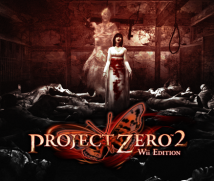1. The Worst Happy Ending Imaginable
I am joined today by two guests from Tecmo Koei Games - the producer and director responsible for overseeing the development of Project Zero 2: Wii Edition. Thank you very much for joining me. Could I start by asking both of you to introduce yourselves?
My name is Keisuke Kikuchi, and I work at Tecmo Koei Games. As the producer of the Project Zero series, I was involved in various aspects of this title’s development, including the original concept design, and making the final call regarding the game’s features.
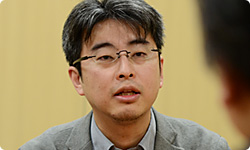
You joined me to discuss Iwata Asks: Spirit Camera: The Cursed Memoir1, so this is your second time taking part in one of these interviews, isn’t it? 1 Spirit Camera: The Cursed Memoir: A horror game based on the Project Zero series released for Nintendo 3DS in January 2012 in Japan. The game utilises Augmented Reality, and includes an AR Book that can be used to take eerie pictures with the Nintendo 3DS cameras.
Yes, that’s right. It’s very nice to be asked back.
My name is Makoto Shibata and I also work for Tecmo Koei Games. As the director of the Project Zero series, I was responsible for the story, game design and overall direction of the project.
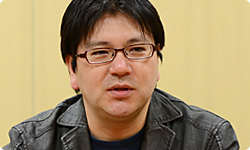
So you have been involved in the Project Zero series right from the very beginning?
Yes, that’s right. I have worked as director and devised the scenarios since the first game in the series. I worked on developing Zero: Tsukihami no Kamen2, together with Osawa-san and Izuno-san3 from Nintendo. 2 Zero: Tsukihami no Kamen was released for Wii in July 2008 in Japan. It was the fourth game in the Project Zero horror series released by Tecmo. It was the first collaborative title by Tecmo Koei Games and Nintendo. The game was not released outside of Japan. 3 Toru Osawa and Toshiharu Izuno both belong to the Software Planning & Development Department at Nintendo. After working on Zero: Tsukihami no Kamen, they worked together with Tecmo Koei on Project Zero 2: Wii Edition.
With this title, you took up the gauntlet of doing a full remake of the second title in the Project Zero series, Fatal Frame II: Crimson Butterly4. Could you tell me a bit about how the project initially came about? 4 Fatal Frame II: Crimson Butterfly was the second title in the series and was originally released by Tecmo in November 2003 in Japan.
Well, as you know, Zero: Tsukihami no Kamen was an original title developed in order to fully utilise the capabilities of the Wii Remote.
Using the Wii Remote as a torch was already included in the concept video that I showed during my keynote speech when revealing the Wii Remote to the public for the first time, at the 2005 Tokyo Game Show.
Yes, that’s right. We came up with something that fit very well with the Project Zero series interface, in terms of the way you explore the game world.
So I suppose you felt that since you’d gone to all the trouble of coming up with this concept, you might as well use it in a new Project Zero title.
Yes, that’s just how it was! (laughs) Then, during the development of Tsukihami no Kamen, we had come up with a lot of ideas but we had been unable to include them all in the game.
So you had a stockpile of ideas you hadn’t had the chance to use?
That’s right. And then there are always those ideas that you only hit upon when work on a title has finished. So the concept for this project was born out of a belief that we could utilise this new control system and rework an existing title to give players a new horror experience that went beyond a mere remake.
What made you choose Crimson Butterfly out of the three Project Zero titles that had been released up to that point?
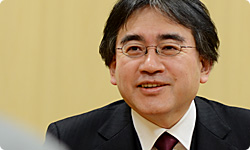
We chose it because the game’s ending really stayed with people, and inspired a great deal of debate concerning its pros and cons. It’s what made this particular game stand out, both within the series, and compared to adventure games in general.
So it sparked a real debate among players?
Indeed it did. One of the endings we’d devised was the worst kind of happy ending imaginable.
So it was a happy ending, but it still managed to be bad?
That’s right. But we knew we couldn’t get away with just having that ending, so I told Shibata-san that we needed another ending. He came back to me, proposing that we should also have the ultimate ‘bad ending’.
(laughs)
So even with multiple endings, there is still no such thing as an ‘ultimate happy ending’. And it seems that the ending we had come up with really resonated with players, making a lasting impression on them. That’s why this game is a particularly memorable one for us all.
Well, if an ending ties up all the loose ends too neatly, it risks not really staying with the player.
That’s right. We thought that having an ending that lingers on in your mind would be more suited to a horror game.
So even though the player finally gets the relief of escaping all those terrifying scenes and the overarching atmosphere of menace, he or she couldn’t finish the game with a sigh of relief. It seems you haven’t budged at all on this aspect.
Indeed. With this new version we’ve kept that same idea - we’ve added several new endings and there’s another happy ending that isn’t quite as straightforward as it seems.
It sounds like you’re keen to reignite the debate! (laughs)
In a sense, I think of this title as a gift we’re giving to those people who played the original, which has taken nine years to be delivered. I think that they’ll embrace it, as a fresh take on the game, with a new flavour to it.
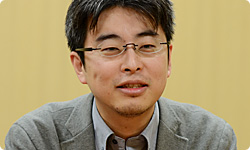
I’d like to pick up on this point about the game having a new flavour. With the action viewed from behind the main character, and the Wii Remote allowing you to look around you, this title has even more of a fresh feel than we imagined it would, given that it uses the same environment as the original. Even from our perspective, as the ones who created the game, it feels like we are walking around a different world.
So even though you had all played the original countless times, the new control system meant that you got a new impression of the game.
Yes, I would say so. Even if you are performing the same actions, the feel of it is completely different. It’s something that’s quite hard to put into words... Well, take the system in Tsukihami no Kamen, where you reach out to explore things5. 5 Tsukihami no Kamen’s system: By pressing and holding the A Button of the Wii Remote in a variety of different situations, the player character will reach out to touch and explore their environment. This system is used to advance the story.
Ah, yes.
Well, with this title, we’ve included more of this kind of action, allowing the player to peer into rooms, lift things aside, and generally interact with the game world in a dynamic way . This means that even if you are familiar with the world, it will feel fresh and new when you revisit it, so you’ll be drawn into it once more.
In Tsukihami no Kamen, we referred to it as the ‘Touch System’, but with the enhanced version on this title, we like to think it’s become the ‘Touch System Plus’.
The ‘Touch System Plus’, you say? (laughs) In what ways is it an improvement on the original system?
When you reach out to touch an object, you will sometimes be seized by a ghostly hand . But you might be able to quickly pull your hand back to evade it. Or you might get a nasty shock just when you’ve picked up an item and think you can relax. We’ve included all manner of different levels of shocks and surprises.
So the interface in this game brings the fear closer to home, as you wonder whether or not a ghost is about to appear.
That’s right. We’ve put scenes like that throughout the game, which means that the sense of tension is always ratcheted up. So just when you think you’re in the clear, you might be in for a nasty shock. There is an element of unpredictability that keeps you on your toes and gives the game a really fresh feel.
Editor’s note: This interview was originally published on 4th April, 2012 on the Japanese Nintendo website. It features videos captured from the Japanese version of the game. In the UK & Ireland this game will be available in English.
